Project Shirley: Short Films by Shirley Clarke
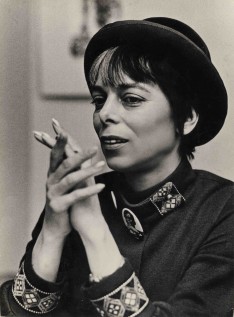
Shirley Clarke, 1970
Tuesday March 3, 2015, 8:00 pm
Los Angeles Filmforum presents
Project Shirley: Short Films by Shirley Clarke
At the Echo Park Film Center, 1200 N. Alvarado St., Los Angeles CA 90026
PLEASE NOTE THE CHANGE IN OUR USUAL DAY AND LOCATION
Dennis Doros and Amy Heller of Milestone Films in person!
“Dancer, bride, runaway wife, radical filmmaker and pioneer —
Shirley Clarke is one of the great undertold stories of American independent cinema.”
— Manohla Dargis, New York Times
The first program I ever curated for Los Angeles Filmforum (with Cheng-Sim Lim of the UCLA Film & Television Archive) was a Shirley Clarke retrospective in 1998, the year after her death. Soon after that, and for much of the next decade, knowledge of her work started to fade, as can happen after the death of independent filmmakers. But several years ago Dennis Doros and Amy Heller of Milestone Films started the remarkable Project Shirley to restore her films and to bring them out in pristine DVD and Blu-Ray editions, loaded with extras. Milestone Films has already brought out marvelous editions of the classic films Portrait of Jason and Ornette: Made in America, and The Connection. Later in 2015 comes The Magic Box, an amazing three-disc collection of her short films and ephemera. Filmforum is delighted to host the forces behind Milestone Films tonight as we present some of Shirley Clarke’s wonderful short films, from her earliest dance films, Dance in The Sun and Bullfight through the avant-garde classic Bridges-Go-Round, to her 1970s video experiments in dance and drama such as Trans and Tongues. -- Adam Hyman
“Shirley Clarke was a gorgeously baroque and complex personality, a character worthy of a novel or two. But what she did as a filmmaker, the subjects she chose, and how she related as a director to her medium has become so much a part of the vocabulary of cinema that her movies – The Cool World, for instance, or Ornette in America -- are nothing less than essential. Happily, Milestone is making it possible to see these films the way they should be seen." – John Anderson, New York Film Critics Circle
Shirley Clarke (1919-1997) was a vital part of the burgeoning post-war American film movement and one of the leading figures in what came to be seen as independent American film. She was one of the first signers — and the only woman — of the New American Cinema manifesto in 1961. “Despite having been acknowledged by filmmakers such as Jean-Luc Godard, Ingmar Bergman and John Cassavetes, her work has not drawn attention on a par with its merit. Clarke was a passionate advocate of independent filmmaking, a woman working in a male industry par excellence and a European cinema enthusiast. All these qualities are irreconcilable with the profit-making motives of cinema as an institution and this might provide an explanation for her interest in outcasts and outsiders. In her words: “I always felt alone and on the outside of the culture I was in. I grew up in a time when women weren’t running things. They still aren’t’. Despite the difficulties she faced throughout her career, her films are still alive and full of a performative energy, which proves that innovative filmmaking does not rely on technological tricks and cosmetics, but on an understanding of the medium’s performative potential and on a good eye for social observation.” - Angelos Koutsourakis, Senses of Cinema
Shirley Clarke interview with Dee Dee Halleck: http://davidsonsfiles.org/shirleyclarkeinterview.html
Biographical essay on Shirley Clarke on Senses of Cinema by Angelos Koutsourakis
Tickets: $10 general, $6 students/seniors; free for Filmforum members. Available by credit card in advance from Brown Paper Tickets at http://bpt.me/1311896 or at the door.
Milestone Films was started in 1990 by Amy Heller and Dennis Doros out of their New York City one-room apartment and has since gained an international reputation for releasing classic cinema masterpieces, groundbreaking documentaries and American independent features. Thanks to the company’s work in rediscovering and releasing important films such as Alfred Hitchcock’s Bon Voyage and Aventure Malgache, Charles Burnett’s Killer of Sheep, Kent Mackenzie’s The Exiles, Lionel Rogosin’s On the Bowery, Mikhail Kalatozov’s I Am Cuba, Marcel Ophuls’s The Sorrow and the Pity, the Mariposa Film Group’s Word is Out, Shirley Clarke's The Connection and Ornette: Made in America, Milestone has long occupied a position as one of the country’s most influential independent distributors.
In January 2008, the Los Angeles Film Critics Association chose to give its first Legacy of Cinema Award to Dennis Doros and Amy Heller of Milestone Film & Video “for their tireless efforts on behalf of film restoration and preservation.” And in March 2008, Milestone became an Anthology Film Archive’s Film Preservation honoree. In 2009, Dennis Doros was elected as one of the Directors of the Board of the Association of the Moving Image Archivists and established the organization’s press office in 2010.
In 2011, Milestone was the first distributor ever chosen for two Film Heritage Awards in the same year by the National Society of Film Critics for the release of On the Bowery and Word is Out. In December 2012, Milestone became the first-ever two-time winner of the prestigious New York Film Critics’ Circle’s Special Award, this time for its work in restoring, preserving and distributing the films of iconoclast director Shirley Clarke.
---------------
This program is supported by the Los Angeles County Board of Supervisors through the Los Angeles County Arts Commission; the Department of Cultural Affairs, City of Los Angeles; and the Mike Kelley Foundation for the Arts. Additional support generously provided by American Cinematheque. We also depend on our members, ticket buyers, and individual donors.
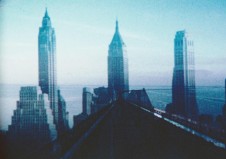
Bridges-Go-Round
Bridges-Go-Round
(1958, 16mm, 3:50)
Jazz Score by Teo Macero
Perhaps Clarke's most famous film is this abstract, brilliantly colored kaleidoscope of New York City's bridges appearing to dance. This avant-garde mix of visual and sound has become legendary not only as a masterpiece of the postwar Indie scene, but as a film to be screened two times whenever it was shown — the two scores creating seemingly different films.
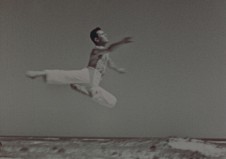
Dance in the Sun
Dance in the Sun
(1953, b&w, 16mm, 7:03)
With Daniel Nagrin. Music: Ralph Gilbert. Screened at the Museum of Modern Art as the Best Dance Film of 1953.
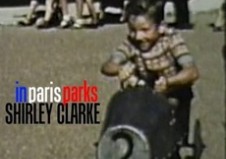
In Paris Parks
In Paris Parks
(1954, color, 16mm, 13:05)
Discovering her original subject had left Paris, and with nothing to do, Clarke found herself taking her daughter Wendy to the park. She realized that the playing of the children was in itself a dance. So she made “a dance of life" that reveals an intimate, charming and loving vision of a now-lost Paris.
"In In Paris Parks, what is choreographed is the mundane and everyday activity in a park in Paris. While the film starts with the populated park focusing on ordinary events, it finishes with the park emptying during the evening. Clarke’s filming is, as DeeDee Halleck says, ‘a lyrical look at gesture and movement in a public landscape’ (DeeDee Halleck, ‘Interview with Shirley Clarke’, in http://davidsonsfiles.org/shirleyclarkeinterview.html) concerned with finding emptiness in movement and movement in emptiness.” - Angelos Koutsourakis, Senses of Cinema
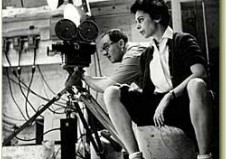
Shirley Clarke directing Bullfight
Bullfight
(1955, color, 16mm, 9:00)
The only filmed performance of the legendary dancer/choreographer Anna Sokolow, Clarke cuts between a bullfight and Sokolow's incredible, intensely passionate interpretation of bullfighter, audience and the bull.
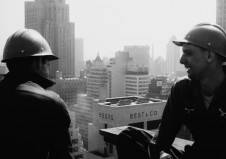
Skyscraper
Skyscraper
(1959, b&w and color, 16mm, 20:00)
In collaboration with Willard Van Dyke, Irving Jacoby, Wheaton Galentine, and D.A. Pennebaker; produced by Willard Van Dyke; Script by John White; Music by Teo Macero. Clarke joined Irving Jacoby and Willard Van Dyke on a short film about 666 Fifth Avenue (known as the Tishman Building), then a year under construction. Clarke later called it “a musical comedy about the building of a skyscraper.” The film received an Academy Award nomination for Best Short Live Action.
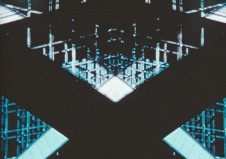
Bridges-Go-Round
Bridges-Go-Round (2nd version)
(1958, 16mm, 3:50)
Electronic score by Louis and Bebe Barron.
Perhaps Clarke's most famous film is this abstract, brilliantly colored kaleidoscope of New York City's bridges appearing to dance. This avant-garde mix of visual and sound has become legendary not only as a masterpiece of the postwar Indie scene, but as a film to be screened two times whenever it was shown — the two scores creating seemingly different films.
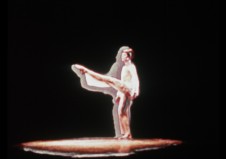
Four Journeys Into Mystic Time: Trans
Four Journeys Into Mystic Time: Trans
(1978, 16mm film & video, color, 9 min.)
The third part of the filmic journey; overall a 60 minute film made in the late 1970s. Produced by Clarke and David Cort; choreographed by Marion Scott; music by Morton Subotnick; dancer: Carol Warner. Won first prize at the New York Dance Film Festival
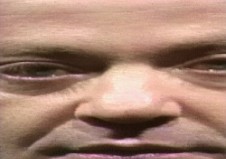
Tongues
Tongues
(1982, color, 1 inch video, 20:22)
Written by Sam Shepard; performed by Joseph Chaikin; music by Sam Shepard, Skip LaPlante; edited by Clarke and Steven Browne; produced by the Women’s Interart Center.
TONGUES and SAVAGE/LOVE are two brilliant video collaborations between playwright Sam Shepard, actor/playwright Joseph Chaikin and Clarke with astonishing visual effects for its time.
"A tour-de-force synthesis of theater and video, Tongues is the collective title of a two-part collaboration by Shirley Clarke, distinguished actor/director Joseph Chaikin, and Pulitzer Prize-winning playwright Sam Shepard. Both one-act monologues integrate the distinctive styles of these three artists: Shepard's innovative, stream-of-consciousness language; Chaikin's kinetic and exacting performance, which unifies the pieces; and Clarke's dynamic, expressive choreography of image, sound and text. The cadences and inflections of Shepard's jazz-related narrative voice and Chaikin's dramatic expression of a multitude of personalities are heightened by Clarke's syncopated use of digital effects, slow motion, and editing techniques to distort and manipulate the image." - Electronic Arts Intermix
